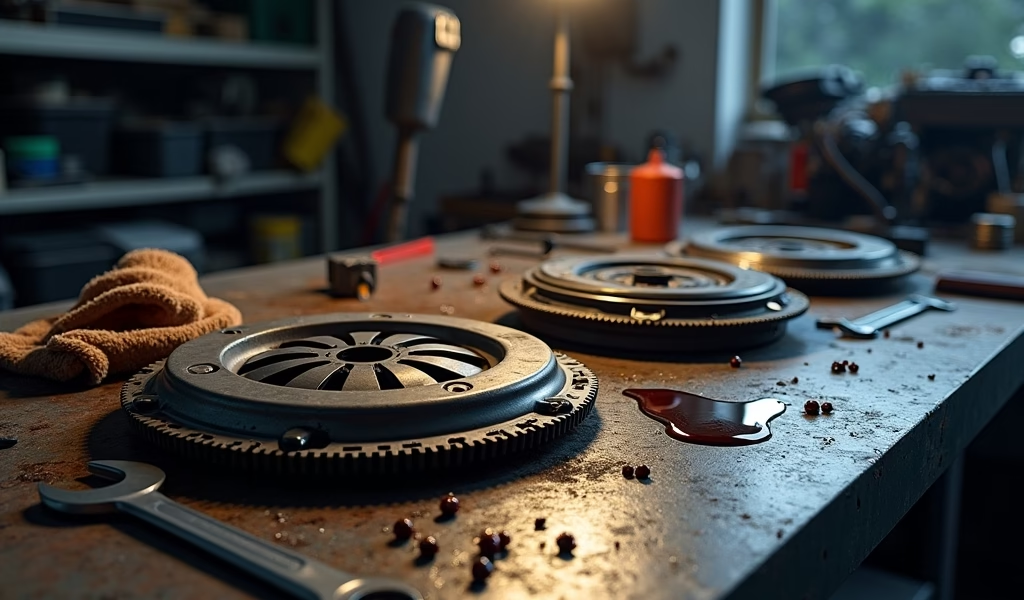Overview
This article provides a detailed guide for replacing limited slip differential clutch packs, covering everything from identifying failure symptoms to step-by-step replacement instructions and maintenance tips. It emphasizes the importance of proper installation techniques, required tools, and post-installation testing to restore optimal traction, handling, and performance to vehicles equipped with limited slip differentials.
Table of Contents
- Understanding Limited Slip Differentials
- Signs of a Failing Clutch Pack
- Tools and Materials Needed
- Preparing for the Job
- Step-by-Step Clutch Pack Replacement
- Reassembly and Testing
- Maintenance Tips
- Conclusion
- Frequently Asked Questions
Understanding Limited Slip Differentials
Limited slip clutch pack replacement is an essential maintenance procedure that can restore performance to vehicles equipped with limited slip differentials (LSDs). Unlike open differentials that allow wheels to spin independently, LSDs transfer power to the wheel with the most traction, improving handling and performance in challenging conditions. The heart of this system is the clutch pack—a series of friction and steel plates that engage to limit wheel slippage.
These clever mechanical systems work by applying resistance between the two output shafts when one wheel begins to lose traction. When working properly, a limited slip differential provides noticeable benefits in cornering stability, acceleration on loose surfaces, and overall driving dynamics. Performance enthusiasts and off-road drivers particularly appreciate these advantages during spirited driving or when navigating difficult terrain.
The clutch pack itself operates on a straightforward principle. When torque is applied unevenly across the axle, clutch plates compress together, creating friction that helps transfer power from the slipping wheel to the one with better grip. Over time, this friction material wears down—just like a vehicle’s transmission clutches—requiring replacement to maintain optimal performance. Engineering experts at Car and Driver note that proper differential function can significantly impact vehicle handling characteristics.
Signs of a Failing Clutch Pack
Recognizing the symptoms of a worn clutch pack early can save more extensive repairs down the road. The most common indicator is a noticeable change in vehicle behavior during turns or acceleration. When clutch plates wear thin, they can’t create sufficient friction to transfer power effectively between wheels.
Unusual noises often serve as the first warning sign. A chattering or growling sound when cornering typically indicates clutch plate wear. These sounds tend to be most pronounced during tight, low-speed turns when the differential is working hardest to manage the speed difference between inner and outer wheels.
Performance degradation represents another telltale sign. Drivers might notice increased wheel spin during acceleration, particularly on slippery surfaces. The vehicle may feel less planted during cornering, with a tendency to push through turns rather than maintain the intended line. In extreme cases, the differential might begin behaving more like an open differential, defeating the purpose of having an LSD.
Leaking differential fluid can also signal trouble. When seals deteriorate, they allow the specialized limited slip differential additive to escape, further accelerating clutch pack wear. Fluid that appears dark, burnt, or contains metal particles suggests internal component damage that requires immediate attention.

Tools and Materials Needed
Proper preparation is essential for successful limited slip clutch pack replacement. Gathering all necessary tools and materials before beginning will prevent frustrating interruptions mid-project. This comprehensive list covers everything needed for most vehicle applications.
Essential Tools:
- Floor jack and jack stands
- Socket set with extensions (metric and standard)
- Torque wrench
- Breaker bar
- Differential cover gasket scraper
- Drain pan (minimum 3-quart capacity)
- Dial indicator with magnetic base
- Feeler gauge set
- Plastic mallet
- Seal puller
- Bearing separator
- Snap ring pliers
- Punch set
- Parts cleaning brush
Required Materials:
- New clutch pack kit (specific to vehicle model)
- Differential cover gasket
- High-quality limited slip differential fluid
- Limited slip additive (if required)
- Assembly lube
- Thread locker
- Brake cleaner
- Shop towels
- Disposable gloves
When selecting replacement parts, quality matters significantly. Clutch plates from reputable manufacturers like Eaton, Auburn Gear, or OEM sources will provide better performance and longevity than generic alternatives. According to differential rebuilding experts at Motor Trend, investing in premium components can extend service intervals by 30-50% under normal driving conditions.
For specialized tools that might only see occasional use, consider rental options from local auto parts stores. Many offer professional-grade tools through rental programs, making this project more economical for DIY mechanics who may not need these tools regularly.
Preparing for the Job
Preparation creates the foundation for a smooth limited slip clutch pack replacement. Begin by thoroughly cleaning the work area and ensuring adequate lighting. A cluttered or poorly lit workspace increases the risk of errors and lost components during disassembly.
Safety must remain the priority throughout this procedure. Always support the vehicle securely on jack stands after lifting, never relying solely on a floor jack. Position the stands on the vehicle’s designated lift points, usually indicated in the owner’s manual. Wheel chocks placed at the opposite end provide additional security against unexpected movement.
Documentation becomes invaluable during reassembly. Before removing any components, take numerous photos from multiple angles using a smartphone or digital camera. These visual references will prove essential when putting everything back together, especially for first-time DIYers unfamiliar with differential internals.
Create a systematic approach to parts organization. Use labeled containers or a segmented tray to store fasteners and small components in the order of removal. This simple step prevents the frustration of missing hardware and ensures correct reinstallation sequence.
Reference materials provide critical guidance throughout the project. Factory service manuals offer precise specifications for clearances, torque values, and assembly procedures specific to the vehicle model. These manuals can often be found online through manufacturer resources or automotive forums. Having these specifications on hand prevents guesswork that could lead to premature failure of the new clutch pack.
Step-by-Step Clutch Pack Replacement
The clutch pack replacement process requires patience and attention to detail. Following these comprehensive steps will guide you through the entire procedure from disassembly to final adjustment.
1. Draining and Accessing the Differential
Begin with the vehicle securely supported on jack stands and the wheels removed for better access. Locate the differential cover and position a drain pan beneath it to catch fluid. Remove the cover bolts in a cross pattern, loosening each bolt gradually to prevent warping.
As the final bolts are removed, the differential cover may remain attached due to the gasket and fluid pressure. Gently tap the cover’s edge with a plastic mallet to break the seal. Avoid using screwdrivers as prying tools, as they can damage the sealing surfaces. Allow all fluid to drain completely before proceeding.
2. Removing the Carrier Assembly
With the differential cover removed, you’ll now have visual access to the carrier assembly and ring gear. Before proceeding, mark the bearing caps and housing to ensure proper reinstallation orientation. Remove the bearing cap bolts and carefully extract the bearing caps, keeping track of their positions.
The carrier assembly can now be removed from the housing. This component contains the clutch pack, ring gear, and carrier bearings. Handle it with care to avoid damaging the ring gear teeth. Place the assembly on a clean work surface for the next steps.
3. Disassembling the Differential
With the carrier removed, document the component positions before disassembly. Remove the ring gear bolts, typically requiring a significant amount of torque to break free. If the ring gear doesn’t separate easily, light taps with a brass hammer can help.
Next, remove the cross pin retaining bolt and extract the cross pin. This allows the spider gears and side gears to be removed. Take careful note of any shims or thrust washers and their exact positions. The clutch packs are typically located behind the side gears and can now be accessed.
4. Inspecting Components
Thoroughly inspect all removed components for signs of damage or excessive wear. Side gears should show even wear patterns without chipping or pitting. Spider gears should rotate smoothly on their shafts. Thrust washers should have consistent thickness without scoring or heat discoloration.
The old clutch plates will likely show visible wear. Friction plates may appear glazed or have uneven material thickness. Steel plates should remain flat without warping or heat damage. If any carrier bearings show pitting, flaking, or rough rotation, they should be replaced simultaneously.

Reassembly and Testing
Reassembly requires meticulous attention to detail and proper torque application. Begin by thoroughly cleaning all components that will be reused. Parts cleaning solvent and a brush help remove old lubricant and debris that could compromise the new clutch pack’s performance.
1. Installing the New Clutch Pack
Refer to the manufacturer’s specifications for the correct stacking order of clutch plates. Typically, installation begins with a steel plate followed by a friction plate, alternating until the pack is complete. Soak the friction plates in the recommended limited slip differential fluid for at least 30 minutes before installation.
Apply a thin coat of assembly lube to all contact surfaces during reassembly. This provides initial lubrication until the differential fluid circulates during operation. When installing the side gears, ensure they rotate freely while maintaining proper mesh with the spider gears.
2. Setting Preload and Backlash
Proper preload and backlash settings are critical for quiet operation and longevity. Reinstall the carrier assembly with any required shims as noted during disassembly. The bearing caps must be installed in their original positions and torqued to specification in an alternating pattern.
Use a dial indicator to verify backlash between the ring and pinion gears. Most applications specify between 0.005 and 0.010 inches of backlash. Adjustments are made by moving shims from one side of the carrier to the other. Maintain proper bearing preload throughout this process by following the manufacturer’s procedure.
3. Final Assembly and Fluid Fill
With backlash and preload correctly set, install a new gasket on the differential cover. Apply a small bead of RTV sealant at the corners for added protection against leaks. Reinstall the cover using the proper torque sequence, typically starting with center bolts and working outward.
Fill the differential with the specified limited slip differential fluid through the fill hole. Most differentials require between 2 and 3 quarts of fluid. Be sure to add any required limited slip additives according to the manufacturer’s recommendations. After filling, reinstall the fill plug and torque to specification.
4. Break-in Procedure
Proper break-in allows the new clutch plates to seat correctly. Drive the vehicle normally for the first 500 miles, avoiding harsh acceleration, heavy towing, or aggressive cornering. This gentle break-in period helps establish proper wear patterns on the friction surfaces.
After the initial break-in period, check for leaks around the differential cover and axle seals. Some limited slip differentials benefit from a fluid change after the break-in period to remove any particles generated during the seating process.
Maintenance Tips
Proper maintenance extends the service life of the new limited slip clutch pack. Regular fluid checks should become part of routine vehicle maintenance. Inspect the differential cover for signs of leakage during oil changes or every 3,000 miles.
Differential fluid requires periodic replacement, typically every 30,000 to 50,000 miles for street-driven vehicles. Performance or off-road applications may need more frequent service intervals. Always use the manufacturer’s recommended fluid type and any required limited slip additives.
Driving habits significantly impact clutch pack longevity. Repeated aggressive launches, burnouts, and drifting accelerate wear. Research from the Society of Automotive Engineers indicates that gentle acceleration from stops can double the service life of limited slip clutch packs compared to aggressive driving styles.
Temperature management also plays a crucial role in differential health. Extended high-speed driving or towing can elevate differential temperatures beyond optimal ranges. Aftermarket differential covers with cooling fins or dedicated coolers provide valuable temperature reduction for demanding applications.
Conclusion
Successfully completing a limited slip clutch pack replacement represents a significant achievement for any DIY mechanic. This comprehensive procedure restores optimal performance to the vehicle’s differential system, enhancing traction, handling, and overall drivability. By following the detailed steps outlined in this guide, even those with moderate mechanical experience can tackle this complex job with confidence.
The benefits of a properly functioning limited slip differential extend beyond performance. Improved traction translates to enhanced safety in challenging driving conditions like rain, snow, or loose surfaces. Additionally, the preventative maintenance performed during this procedure often identifies other potential issues before they develop into costly repairs.
For those who have completed this job, the knowledge and skills gained provide a deeper understanding of vehicle dynamics and drivetrain systems. This foundation makes future maintenance tasks less intimidating and builds confidence for tackling other advanced automotive projects. Remember that patience, attention to detail, and following manufacturer specifications are the keys to a successful limited slip clutch pack replacement that will deliver years of reliable service.
Frequently Asked Questions
How long does a limited slip clutch pack typically last?
Under normal driving conditions, a quality limited slip clutch pack typically lasts 60,000 to 100,000 miles. Driving style, maintenance practices, and vehicle application significantly impact service life.
Can I replace just the clutch pack without rebuilding the entire differential?
Yes, in many cases the clutch pack can be replaced without a complete differential rebuild. This requires removal of the carrier assembly but can be less involved than a full rebuild if the other components are in good condition.
How much does professional limited slip clutch pack replacement cost?
Professional replacement typically costs between $800 and $1,500, depending on vehicle make and model. Labor accounts for approximately 60-70% of this cost due to the technical expertise required.
What happens if I don’t replace a worn clutch pack?
A worn clutch pack will eventually lead to complete loss of the limited slip function. The differential will then operate as a standard open differential, resulting in reduced traction and compromised handling.
Can I use regular differential fluid in a limited slip differential?
No, limited slip differentials require specific friction-modifying additives for proper clutch pack operation. Using standard differential fluid without these additives will cause clutch chatter and accelerated wear.

